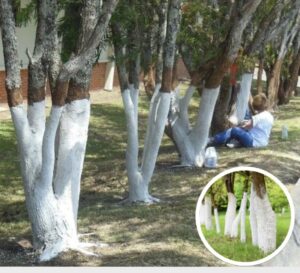Why Are Some Tree Trunks Painted White? The Real Reason Behind This Curious Sight

Note: This story was originally reported in June 2023 and is being reshared for those who may have missed it.
As you scroll through the world of gardening forums and online plant groups, you’ll quickly realize one thing—tree lovers are a dedicated bunch. These passionate growers put serious effort into nurturing trees, especially fruit-bearing ones, and they often rely on unusual methods to protect their leafy companions. Maybe you’ve noticed some trees covered with netting, or more curiously, tree trunks that are painted white. What’s going on there?
Trees with their lower trunks painted white | Wikimedia Commons
If you’ve ever seen trees marked with orange spray paint, you might know that typically means the tree is marked for removal. Purple markings often signal private property lines and serve as a warning to trespassers. But what about when the lower portion of a tree is painted in a clean, bright white?
That paint is more than just decoration—it’s a form of protection.
Painting the bottom of tree trunks white helps shield them from a winter condition called sunscald. During colder months, the rapid shift from freezing nighttime temps to warm, sunny afternoons can stress a tree’s bark. This sudden temperature swing causes the outer layers to expand and contract quickly, sometimes leading to bark cracking or splitting. White paint reflects sunlight, keeping the trunk’s temperature more stable and reducing the chance of damage.
This simple technique is especially common among young trees in residential areas and commercial orchards, where bark is thinner and more vulnerable.
Roadside trees with trunks painted white | Wikimedia Commons
But not just any paint will do. The best kind for this job is water-based latex paint—nothing oil-based. Most tree caretakers mix it with an equal amount of water to get the right consistency. Some even go a step further by adding joint compound to the mix, which creates a thicker barrier that also helps keep out insects that like to bore into bark.
And when it comes to applying the paint, a brush is the tool of choice. While spraying might be faster, it doesn’t always provide the same coverage and protection. For many, this painting process becomes an annual tradition—like putting a coat on a child before sending them into the winter cold.
Protective white paint prevents insect damage and sunscald | Wikimedia Commons
So the next time you come across a tree with a white base, you’ll know it’s not a random act—it’s a smart, preventative measure. Behind each white stroke is a gardener, farmer, or nature lover doing their best to give trees a fighting chance against harsh weather and pests. It’s just one of the many ways people quietly care for the natural world around us.